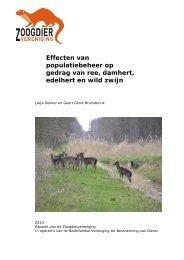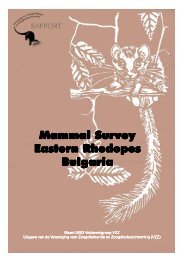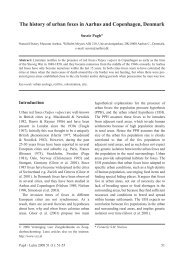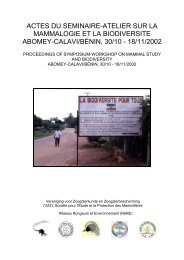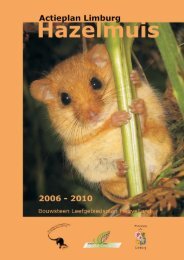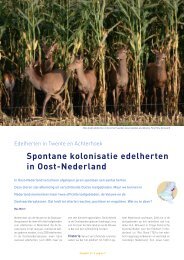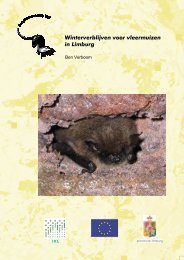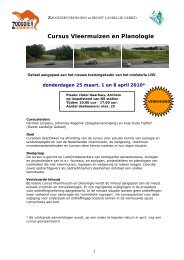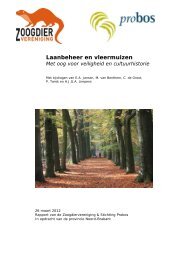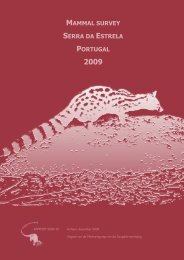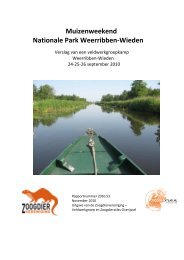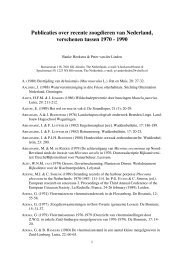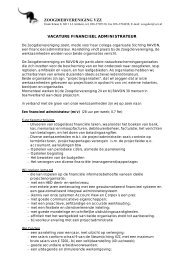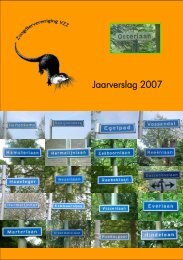Mammal survey Pol'ana - De Zoogdiervereniging
Mammal survey Pol'ana - De Zoogdiervereniging
Mammal survey Pol'ana - De Zoogdiervereniging
You also want an ePaper? Increase the reach of your titles
YUMPU automatically turns print PDFs into web optimized ePapers that Google loves.
Wood Wood mouse mouse mouse ( (Apodemus ( Apodemus sylvaticus sylvaticus) sylvaticus<br />
In the Netherlands the Wood mouse is one of the most common small mammal species. In Pol’ana this<br />
species was only captured in relatively small numbers in four of the nine lines of traps. It was striking to see<br />
that in some lines bigger numbers of already marked Wood mice were written down than was possible on<br />
the ground of the number of known captures in the line of the species. This points to the fact that in a<br />
number of cases Yellow-necked mice will be determinated as common Wood mice. Especially with young<br />
animals, noting the difference between the Wood mouse and the Yellow-necked mouse can be very difficult.<br />
Northern Northern Northern House House mouse mouse ( (Mus ( Mus musculus musculus musculus musculus musculus) musculus musculus ) (see (see also also text text box)<br />
box)<br />
In Slovakia two sorts of House mice occur: the Northern House mouse (Mus musculus musculus; also known<br />
as the Eastern House mouse) and the Steppe mouse (M. spicilegus). In the field these two are very hard to<br />
keep apart. Certain determinations can be done from characteristics of the skull. M. spicilegus only occurs in<br />
the most southern part of Slovakia along the border with Hungary, and it is not known from the Pol’ana<br />
region. Therefore it is assumed that the House mice seen during the workshop are of the species M.<br />
musculus. House mice were captured in the lines A1 and G. In line G the species was captured no less than<br />
23 times. The House mice on location A were (for Dutch concepts) remarkably small individuals, which did<br />
seem to be sexually active. That is why the specimens captured were initially determinated as Small Wood<br />
Mouse (Apodemus microps). On the score of, among other things, the presence of an indentation in the rim<br />
of the cutting tooth of the upper jaw, animals were later determinated to be a House mouse after all. The<br />
indentation mentioned is typical for the genus Mus and is missing in the genus Apodemus.<br />
The The views views on on the the taxonomy taxonomy of of House House mice mice mice are are not not not unambiguous. unambiguous. In In this this text text box box you you will will find find the the concep conception concep tion as as can<br />
can<br />
be be found found found on on the the Dutch Dutch site site of of wikipedia.org wikipedia.org under under “huismuis”. “huismuis”.<br />
“huismuis”.<br />
Based on the genetic data of the House mouse five different groups are distinguished, which are mostly seen as<br />
subspecies (of Mus musculus), but also as separate species.<br />
Western Western House House mouse mouse mouse ( (M. ( M. m. m. domesticus domesticus) domesticus domesticus<br />
This form appears in Greece, the south of Bulgaria, Macedonia, Albania, Montenegro, the Dalmatic coast, Italy,<br />
Switzerland, most parts of Germany, the Benelux, France, Iberian Peninsula and the British Isles, Asia from Turkey to<br />
Iran, America, Australia and Africa. Right across Europe there is a hybrid zone of this form of House mouse with the<br />
Northern House mouse. In the Caucasus an even wider hybrid zone is present. Further to the east the form probably<br />
merges gradually into M. m. castaneus).<br />
Northern Northern House House House mouse mouse mouse ( (M. ( M. m. m. musculus musculus) musculus musculus)<br />
)<br />
The Northern House mouse is also called Eastern House mouse. The form can be found on the eastern side of the<br />
area of occurance of the Western House mouse, right into the north of China. The border with the Western House<br />
mouse runs from <strong>De</strong>nmark through Germany and Austria and through the Balkan as far as Bulgaria. Also in the<br />
Caucasus the two forms meet. In Eastern Asia its area of occurance borders that of the Asian House mouse (M. m.<br />
castanenus). Also in Iceland the Northern House mouse is seen. The House mice in Japan are probably the result of<br />
cross-breeding of the Asian and Northern House mouse.<br />
Asian Asian House House House mouse mouse ( (M. ( M. m. m. castan castaneus castan castaneus<br />
eus) eus )<br />
This form can be found from Afghanistan to Taiwan, on the Mariana Islands and in New Guinea. The House mice in<br />
Japan are probably the result of cross-breeding between the Northern and the Asian form.<br />
M. M. m. m. bactrianus bactrianus<br />
bactrianus<br />
This form appears in Afghanistan, Pakistan and in the north of India.<br />
M. M. m. m. gentilulus gentilulus<br />
gentilulus<br />
This form appears in Jemen and on Madagascar.<br />
House mice are real followers of culture: wherever people are, House mice are also present. Originally the House<br />
mouse appears on the steppe of Central Asia and Russia, from whereon it spread rather quickly to the rest of the<br />
world, via commercial routes and through the spreading of human settlements. By way of ships the species reached<br />
America and Australia.<br />
Other European species of the genus Mus, like M. macedonicus, M. spicilegus and M. spretus, are also called<br />
“House mouse”. Also Mus fragilicauda from Thailand is closely related to the House mouse.<br />
<strong>Mammal</strong> <strong>survey</strong> <strong>Pol'ana</strong> (Slovakia) 2005 21



